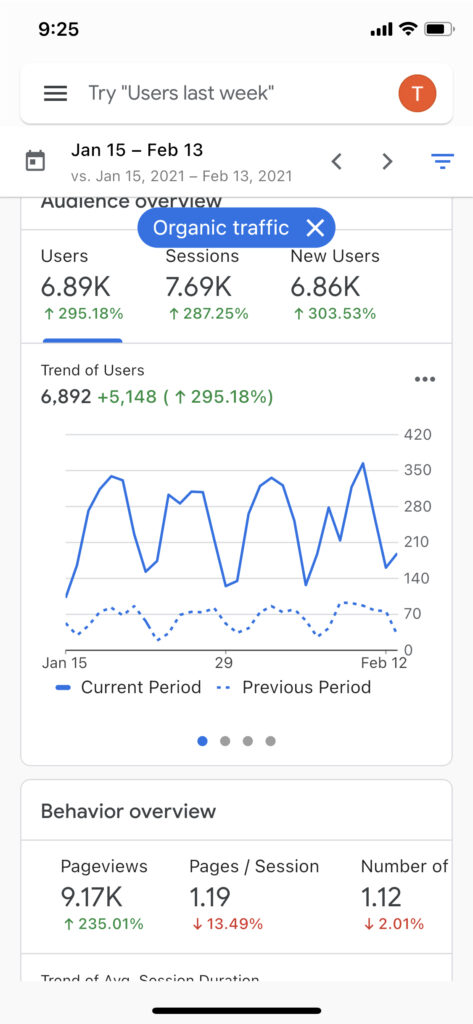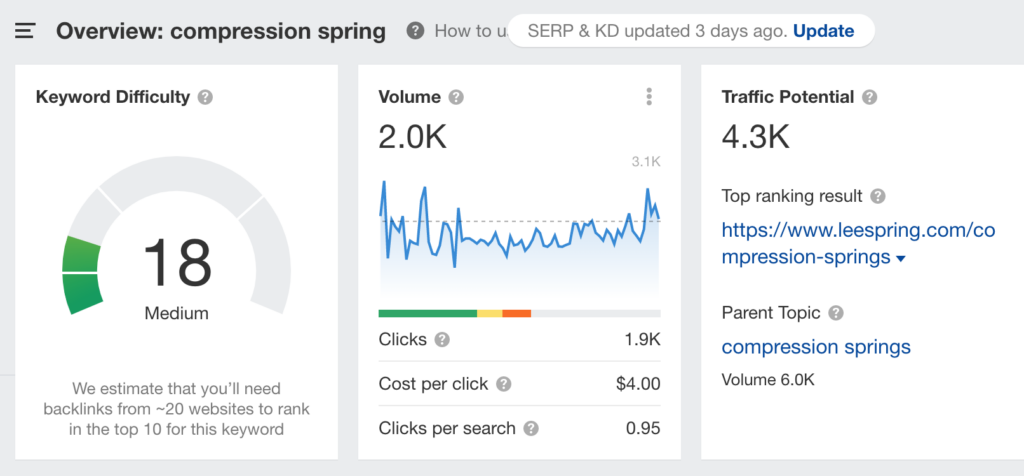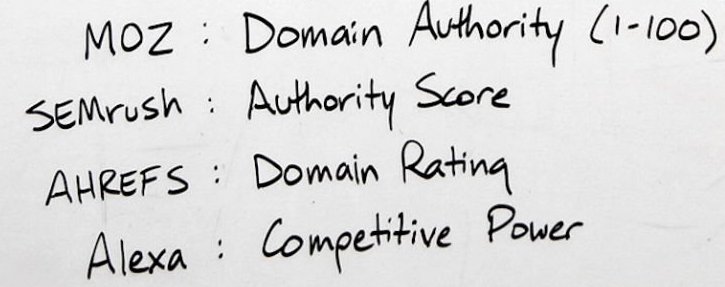Search engine optimization (SEO) is the art of making a business viewable to search engines and thus improving the quality and quantity of your web traffic. The industrial market has historically been a heavy-touch industry with relationships built from handshakes and lunches. That has and will remain the best to conduct business.
Yet.
I’m the Editor-in-Chief of an equipment blog. In a single year, with no press outreach or paid ads, traffic skyrocketed 300%.

There’s an industrial HVAC company out of Houston. One day there were averaging ~80 organic visitors a day. In a matter of days, their traffic skyrocketed to around 300 organic visitors a day.

In the first scenario, internal SEO led to explosive growth while in the 2nd example, external SEO provided the HVAC company with a massive lift. In this article, we’ll explore the benefits of both and how to ensure your company leverages both effectively.
Internal SEO – It’s All About Content
For centuries, human beings penned letters, books, and memos to persuade others. Their ability to deliver their message ultimately relied on the means of delivery. Whether that means of delivery was a postman or a publishing house, some human-controlled entity provided fulfillment. Often, the means of message delivery was as important as the message itself.
Today, Google and associated search engines provide the means of delivery for most of what web surfers consume. Preparing a company for effective growth requires a strong understanding of the Google algorithm, maximizing internal SEO on a website, and producing content that ranks.
Understanding the Google Algorithm
Let’s talk about how the Google search engine (and any modern search engine) operates. When you Google something, Google doesn’t actually go out to the web. Instead, Google presents a pre-built map of the best possible options for that keyword. This pre-built map is generated from a Googlebot crawling around the web and making the best possible interferences from on-page content and linking.

To get your company on that map, think of the Googlebot as one of the robot vacuum cleaners and your website as your apartment. Turn on that robot vacuum with no preparation and your apartment probably gets mostly clean. But pick up the sweaty gym bag and pizza box, block the robot from going under the couch and the results exponentially improve.
That preparation work is known as internal SEO.
Maximizing Internal SEO for a Website
The main focus when building a new website should deal with how human readers perceive the content. Yet, how Google perceives content holds huge weight. Here’s how to set up a clear path for the Googlebot :
- Text length — The right answer here is usually at least a few hundred words. Anything less and it is hard for the Googlebot to understand the page’s context. Longer, more extensive articles (750+ words) weigh heavier than lighter content.
- Links — Google likes pages link-both internally and externally. This helps Google makes easier sense of the interconnection between on-page content and the web at large. All pages should link internally and externally add coherence to a Googlebot’s web crawl.
- Keyphrase — The key phrase is the primary term you want a page to rank for. It should appear in the title, opening paragraph, and moderately throughout the content. In the early days of Google search, people crammed the entire webpage with the keyphrase they wanted to rank for. That worked for a few years, but Googlebot is a lot smarter now and sees keyword stuffing as spammy behavior.
- Image alt attributes — If an image can’t load properly or the user is visually imparied, the image alt tag adds context to pictures. The Googlebot also prefers images that have the alt tag populated.
Other important elements such as title length, meta descriptions, and meta-text congruency round out the relevant factor list. For major pages on a website, every rule listed above requires examination. Don’t write 750+ words on a landing page – that’s just goofy. Don’t worry about having a unique keyphrase for all your main pages.
In short, ensure the primary target of web copy remains human readers and optimize content for that audience. Yet, applying the best practices of internal industrial SEO should occur wherever practical.
Producing Content That Ranks
If your company manages to produce a speed-optimized website on a powerful hosting platform on the best content management system, it’s already in the top 90%. Continuing to produce great content pushes its online presence into the top 1%.
Every so often, someone posts a vintage ad from the ’50s. The amount of text shocks is shocking. People’s attention was longer in those days fewer ads clogged their cognition.

Today, these ads invoke curiosity and maybe a touch of nostalgia for a time when the public wasn’t overrun by ubiquitous advertising.
Yet, a similar relic remains in the industrial market that prevents companies from realizing the benefit of industrial SEO. Many companies deliberately hide detail of their processes and approaches. The thinking here is that “others will copy the playbook.”

Maybe so. But unless you completely give away the secret sauce, the massive advantage from valuable content far outweighs the risk. So get to cracking on content that makes sense for your target customer AND the Googlebot.
Where to Start?
In industrial SEO land, content can group into three content segments: core content, money content, and informational pages.
- Core content desribes a company’s mission and explains its value. This should be the core of any decent website (Think: About Us, Team, Services)
- Money content persuades a reader to buy the product (Think: Why Gonzaga Spring Company is the Best)
- Info content exists to provide a prospective buyer with information. (Think: How Helicoil Springs Work)
Unfortunately, most industrial companies focus only on the first two types of content. There’s little patience to allow the unfurling of a long, value-driven relationship. “We have to convince them we are the best!”

A better alternative is consistently sharing information that both your potential customers and the Googlebot loves. I’ll assume you have that first item nailed. As for the Googlebot, let’s dive into how to engineer your success.
What Does the Googlebot Love?
Remember the story of the equipment blog gaining 300% visitors within a year? The growth was achieved via producing info content directed to underserved keywords. Here’s the exact process to duplicate the same success:
- Think about what key terms your customers search for. For example, a spring company’s customers might be interested in: “heavy duty springs” or “compression springs”
- Find a software that reverse engineers the Googlebot. Momenta Tech prefers ahrefs.com. Other common competitors are semrush.com and moz.com.
- Plug “heavy duty springs” and “compression springs” into your choosen software.
- You will receive a report on search volume and how difficult it could be to rank for these terms.

- Figure out search intent by opening up an Icognito tab and searching for that term. Peruse some of the articles and quantify two things:
- The site’s popularity that appears in the search.
- The amount of content on the page.
- Determine if it’s plausible that your team could a lengthier or more comprehensive article than what currently exists.
If the answer is yes, then produce a piece of industrial content that meets all required SEO benchmarks. To review, great industrial content looks contains internal and external links, a focus keyphrase, image alt attributes, and appropriate text length (usually longer than 750 words).
External SEO – It’s All about Links
External SEO off-page SEO provides signals from outside your website that the content is worthwhile. In short, external SEO boils down to external inbound links. External links to your content show the Googlebot that it’s worth a look. Backlinks group into two types: do-follow and no-follow. Do-follow links pass “link juice” to the Googlebot that increases the authority of your page. No-follow links do not pass link juice.
While building a link, website owners themselves can characterize links as do-follow or no-follow. But entire domains such as fb.com or wikipedia.com classify as no-follow links. This practice prevents a blog owner from building links into publically accessible domains to boost the rankings of a site.
Do-follow links provide variable input depending on their power. Let’s return to the story of the industrial HVAC company.
The company used a Microsoft product. Microsoft interviewed them for the blog and rewarded their time with a do-follow backlink. As a direct result, the HVAC company experienced an estimated tenfold increase in keywords and a fivefold increase in organic traffic. Microsoft’s domain ranking per Ahrefs.com is 96/100 on a logarithmic scale. Thus, it provides incredibly powerful referral links.
Herein lies an easy SEO lesson for industrial companies. Once you complete a successful project for a client simply ask for a do-follow backlink. Such a low-effort request may easily net hundreds of additional traffic.
A Judicious Link Building Campaign
Linking, however, should not be limited to clients. An aggressive outreach campaign to blogs and other companies will produce huge dividends. Often the site requires an article in return for a backlink. Some might even ask for payment.
Domain Ranking, or DR, determines a site’s power. It and its most commonly used counterpart Domain Authority (DA) reports on a 100 point scale. A cornerstone of an effective outreach program is to understand the target site’s DR. Knowing a site’s DR and whether it provides do-follow links allows for a clear-eyed appraisal of a potential link’s value.

Should you pay for a link? Many site owners will ask for this. The answer is usually not. In the SEO community, there are always rumors of manual actions by Google to manually penalize sites that pay for backlinks. While this occurs, it is much more common for Google to simply ignore backlinks that are bought.
Full transparency: I’ve paid for backlinks in the past without penalty. The key here is to be judicious. If you go around buying thousands of dollars in backlinks from dubious sites, your site may be flagged and certainly won’t see ranking benefits.
Prior to pursuing a link, ask yourself these questions about the subject site?
- Does the site visually appear to be trustworthy?
- Have there been huge, unexplained upswings in traffic in the subject site?
- How’s the article quality?
In Summary
We are starting to notice a sea change in the industrial market where companies are waking up to the power of industrial SEO. Yet, Industrial SEO remains an underserved market. Thoughtful content coupled with an aggressive backlink-building campaign produces a competitive moat that your companies will scramble to duplicate.
Go get it!
Any more questions? Feel free to reach out.